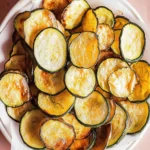The Slow Cooker Ropa Vieja brings the heart of Cuban cuisine to your kitchen with ease and bold flavor. Traditionally made with flank steak simmered in a tomato-rich sauce alongside vibrant bell peppers and aromatic spices, this dish is as visually appealing as it is satisfying. Its name, which translates to “old clothes,” reflects the dish’s appearance—shredded beef that resembles tangled, well-worn clothes. The slow-cooking method allows the flavors to meld together, creating a comforting, savory meal that’s perfect for any occasion.
Perfect for busy weeknights or weekend gatherings, this dish is a set-it-and-forget-it solution that yields incredible leftovers. Serve it over fluffy white rice, tucked into warm tortillas, or piled high on a crusty sandwich roll. However you choose to enjoy it, one bite of this savory, slow-cooked classic will make it a staple in your home kitchen.
Full Recipe:
-
2 pounds flank steak or skirt steak
-
1 tablespoon olive oil (optional for searing)
-
1 green bell pepper, sliced
-
1 red bell pepper, sliced
-
1 yellow onion, sliced
-
4 cloves garlic, minced
-
1 (15-ounce) can crushed tomatoes
-
1/2 cup beef broth
-
1 tablespoon tomato paste
-
1 tablespoon red wine vinegar
-
1 teaspoon ground cumin
-
1 teaspoon dried oregano
-
1/2 teaspoon smoked paprika
-
1 bay leaf
-
Salt and black pepper, to taste
-
Chopped cilantro or parsley, for garnish
Directions:
-
(Optional) Heat olive oil in a large skillet and sear the flank steak on both sides until browned. This adds a rich depth of flavor.
-
Place the steak into a slow cooker. Top with bell peppers, onions, and garlic.
-
In a separate bowl, mix the crushed tomatoes, beef broth, tomato paste, vinegar, cumin, oregano, paprika, bay leaf, salt, and pepper.
-
Pour the tomato mixture over the beef and vegetables in the slow cooker.
-
Cover and cook on low for 8 hours (or high for 4 hours), until the beef is tender and can be easily shredded.
-
Remove the bay leaf. Shred the beef with two forks directly in the pot and stir everything together.
-
Garnish with chopped cilantro or parsley. Serve with rice, in tacos, burritos, or as a sandwich filling.
Prep Time: 20 minutes | Cooking Time: 8 hours | Total Time: 8 hours 20 minutes
Kcal: ~365 kcal per serving | Servings: 6–8 servings
History and Origin
Ropa Vieja, which translates to “old clothes” in Spanish, is one of Cuba’s most iconic dishes. The name is thought to be a nod to the dish’s appearance—shredded beef that resembles tangled, well-worn clothes. The dish’s roots are deeply embedded in Cuban history, with influences from the Spanish and African cuisines that shaped the country’s culinary identity.
The origins of Ropa Vieja can be traced back to Spain, where a similar dish made with beef and vegetables was popular. However, it is in Cuba where the dish truly evolved, with the addition of local ingredients such as tomatoes, peppers, and onions. The dish became popular during the colonial era when beef was relatively inexpensive, making it a hearty meal for families. As with many dishes of this nature, Ropa Vieja was initially a peasant food, but its flavors and versatility eventually made it a staple in Cuban kitchens.
Over time, Ropa Vieja has also found its way to other parts of Latin America and the Caribbean, with variations appearing in places like Puerto Rico, the Dominican Republic, and even parts of Florida. Despite these regional differences, the heart of the dish—the slow-cooked, shredded beef in a tomato-based sauce—remains the same, serving as a comforting reminder of Cuba’s culinary heritage.
Variations and Adaptations
While Ropa Vieja is typically made with beef, there are a number of variations of the dish across regions. For example, in Puerto Rico, you might find a version that includes olives or capers for a slightly briny touch. Some regions of Cuba will add wine, while others opt for more traditional broth and vinegar combinations. Though the base recipe remains largely the same, the use of different vegetables, such as carrots or potatoes, or the incorporation of different spices, can create nuanced flavors.
In terms of meat, while flank or skirt steak is the most common choice, some cooks opt for other cuts of beef that shred easily after slow cooking. Alternatives like chicken or pork can be used as well, offering a different texture and flavor while keeping the essence of the dish intact. Additionally, for those who prefer a lighter option, a vegetarian or vegan version could substitute beef with jackfruit or a plant-based meat alternative. Each adaptation brings a new twist to the traditional recipe, allowing home cooks to customize it according to their preferences or dietary needs.
Nutritional Information
Ropa Vieja is a rich and hearty dish, packed with flavor and nutrients. A typical serving contains a good balance of protein from the beef and healthy fats, as well as vitamins and minerals from the peppers, onions, and tomatoes. While this dish is relatively high in protein due to the beef, it is also rich in vitamins such as Vitamin A, C, and several B-vitamins, all of which play an important role in immune function, energy metabolism, and skin health.
A standard serving of Ropa Vieja (about one-sixth of the total recipe) has approximately:
-
Calories: 365
-
Protein: 30g
-
Carbohydrates: 25g
-
Fat: 15g
-
Fiber: 5g
-
Sodium: 800mg
-
Cholesterol: 70mg
It is important to note that the nutritional value can vary depending on the cuts of meat used and whether additional ingredients such as olives, capers, or extra oil are added. If you want to make it a bit lighter, consider using leaner cuts of beef or reducing the amount of oil and salt used in the recipe.
In addition to its rich nutritional profile, Ropa Vieja provides a great source of iron, zinc, and potassium, all of which are vital for maintaining a healthy body. The combination of slow-cooked beef and vegetables also ensures that the dish is satisfying and filling, making it an ideal option for dinner or meal prepping.
Serving Suggestions and Pairings
Ropa Vieja is an incredibly versatile dish when it comes to serving and pairing. Traditionally, it is served over white rice, which helps soak up the flavorful sauce and offers a simple, yet satisfying base. If you’re looking to elevate your meal, you can serve it alongside black beans, a staple in Cuban cuisine. The rich, savory beef pairs beautifully with the slight sweetness and earthiness of the beans.
For a more casual option, serve Ropa Vieja as a taco or in a burrito, adding a few extra toppings like guacamole, cilantro, or a dollop of sour cream. The shredded beef also works wonderfully in sandwiches, especially when paired with crusty bread or Cuban rolls. You can also use it as a filling for empanadas or arepas for a delicious handheld snack.
When it comes to beverages, a cold, crisp lager or a mojito complements the dish well. If you’re serving it for a more formal occasion, a fruity red wine, such as a Tempranillo or Merlot, can enhance the flavors of the beef without overwhelming it. For non-alcoholic options, fresh limeade or agua fresca with fruit infusions make refreshing pairings.
Tips and Tricks for Success
To ensure your Ropa Vieja turns out perfectly every time, there are a few tips to keep in mind. First, while the recipe calls for slow cooking, it’s important not to rush the process. The beef needs time to break down and become tender, so avoid the temptation to cook it on high heat unless you’re short on time. If you want to add more flavor, sear the beef before adding it to the slow cooker. This extra step helps to lock in the juices and caramelize the exterior, which intensifies the taste.
If you’re using a lean cut of meat, such as flank steak, be sure to check it halfway through cooking to make sure it isn’t drying out. Adding extra broth or a splash of water can help maintain moisture. Additionally, the beauty of slow cooking is that you can let the flavors develop. If you can, cook the dish the night before serving—it allows the ingredients to meld together and enhances the depth of flavor.
When shredding the beef, use two forks and work slowly to pull the meat apart. This will help keep the strands nice and fluffy rather than clumpy. For an even more flavorful dish, feel free to add some extra spices like cumin, chili powder, or smoked paprika to taste.
Potential Health Benefits
Ropa Vieja, while rich and hearty, offers several health benefits when enjoyed as part of a balanced diet. The beef provides a substantial amount of protein, which is essential for muscle repair, immune function, and overall growth. Additionally, beef is a good source of iron, a vital mineral for producing red blood cells and preventing anemia.
The vegetables in the dish, particularly the tomatoes and bell peppers, are rich in antioxidants such as Vitamin C, which can boost the immune system and promote healthy skin. The inclusion of garlic also offers anti-inflammatory benefits and may help to lower blood pressure and cholesterol levels. Furthermore, the slow cooking process helps to retain the nutrients from the vegetables, allowing you to enjoy all the health benefits without sacrificing flavor.
Conclusion
Slow Cooker Ropa Vieja is more than just a meal—it’s a celebration of Cuban cuisine and a nod to the comfort of slow-cooked meals. With its melt-in-your-mouth beef, bold spices, and versatility, it’s no wonder this dish is a favorite for many. Whether you serve it with rice, in tacos, or in sandwiches, Ropa Vieja offers a taste of Cuba that will transport you to the heart of Latin American cooking. Plus, the recipe’s simplicity and adaptability make it perfect for busy weeknights or as a meal for a special occasion. So, why not give it a try? Your taste buds will thank you!





